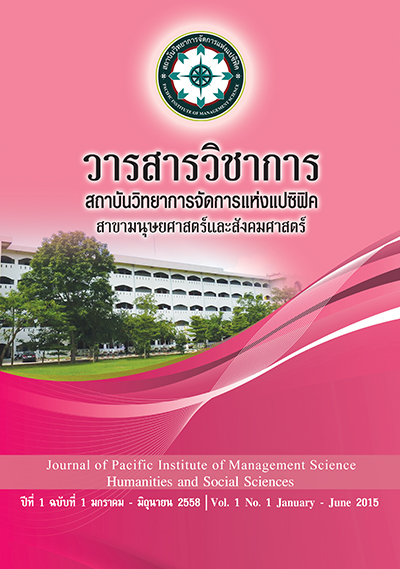Development of Military Officers in Accordance with the Royal Thai Armed Forces’ Development Strategy
Keywords:
Development, Accordance, Royal ThaiAbstract
The purposes of this study are: (1) to study the level of human resources development affecting the effectiveness of the development strategy of the Royal Thai Armed Forces, (2) to study the factors impinging upon the effectiveness of human resources strategy of the Royal Thai Armed Forces; (2) to study the factors impinging upon the effectiveness of human resources strategy of the human resources development model in accordance with the Royal Thai Armed Forces’ development strategy.
The population used in this study is 393 military offices in accordance with the Royal Thai Armed Forces’ Development Strategy. The researcher uses questionnaires and interview as instrumentation in collecting data resulting from relevant currents, theories and researches. The statistics used are frequencies and percentage for the explanation of general characteristics of the data; the mean and S.D. for the explanation of the relationship of factors impinging upon the effective ness via Pearson’s Product Moment Correlation Coefficient, together with multiple regression, with a significance level of 0.05
It was found from the study that the level of overall opinion towards the human resources development in accordance with the Royal Thai Armed Forces’ development strategy is at a mean value of 3.75 Individually, the highest level of human resources development of the Royal Thai Armed Forces is the development of work ethics, followed by building a relationship in the organization, and participators, in that development of preparedness towards ASEAN Community.
As to the analysis of the overall success of the Royal This Armed Forces, it was found that it has a mean score of 3.90. Individually, the highest scores center on professionalism and upholding of good governance, followed by an evaluation system on job satisfaction in human resources development while the least score being the development of professional capability.
With regard to the hypothesis – testing, it was found that traing, education, personnel development; work ethics are related to the strategy development with a significance level of 0.05. On development, building of organization relationship, participation, and development for the preparedness towards ASEAN Community were not found to be related to the development strategy of Thai Royal Armed Forces.
References
ชูชัย สมิทธิไกร. (2542). การฝึกอบรมบุคลากรในองค์การ. (พิมพ์ครั้งที่ 2). กรุงเทพมหานคร : จุฬาลงกรณ์มหาวิทยลัย.
ชำนาญ ปิยวนิชพงษ์ . (2552). กรอบความคิดสำหรับการจัดการทรัพยากรมนุษย์ . กรุงเทพมหานคร : เพียร์สัน เอ็ดดูเคชั่น อินไชน่า.
ณรงค์วิทย์ แสนทอง. (2547). กลยุทธ์การบริหารคนสำหรับคนบริหาร. กรุงเทพมหานคร : เอช อาร์ เซ็นเตอร์ .
ติน ปรัชญพฤทธิ์ . (2544). ศัพท์รัฐประศาสนศาสตร์ (พิมพ์ครั้งที่ 5). กรุงเทพฯ : จุฬาลงกรณ์มหาวิทยาลัย.
ทรัพยากรมนุษย์ มหาวิทยาลัยธรรมศาสตร์ สถาบัน. (2544). รายงานการวิจัยเรื่องบริษัทข้ามชาติกับการพัฒนาทรัพยากรมนุษย์ . กรุงเทพมหานคร : มหาวิทยาลัยธรรมศาสตร์ .
ธานินทร์ กรัยวิเชียร. (2547). คุณธรรมและจริยธรรมของผู้บริหาร. นนทบุรี : ศูนย์ส่งเสริมจริยธรรม สถาบันพัฒนาข้าราชการพลเรือน สำนักงาน ก.พ.
นงลักษณ์ สินสืบผล. (2542). การพัฒนาบุคลากรและการฝึกอบรม. กรุงเทพมหานคร : สถาบันราชภัฎธนบุรี.
แผนปฏิบัติราชการ 4 ปี (2555 - 2558). กองทัพไทยและกองบัญชาการกองทัพไทย
พัฒนาข้าราชการพลเรือน (ก.พ.), สถาบัน. (2547). ยุทธศาสตร์การพัฒนาข้าราชการพลเรือนสำนักงาน ก.พ. กรุงเทพมหานคร : สกายบุ๊กส์ .
แผนยุทธศาสตร์การพัฒนากำลังพลกองบัญชาการกองทัพไทย ( พ.ศ.2553 - 2557). กองทัพไทยและกองบัญชาการกองทัพไทย.
ศิรภัสสรศ์ วงศ์ทองดี (2556). การพัฒนาทรัพยากรมนุษย์ . กรุงเทพมหานคร : สำนักพิมพ์แห่งจุฬาลงกรณ์มหาวิทยาลัย.
สุจิตรา ธนานนท์ . (2550). การพัฒนาทรัพยากรมนุษย์ . (พิมพ์ครั้งที่ 2). กรุงเทพมหานคร : สถาบันับัณฑิต พัฒนบริหารศาสตร์ .
สนุันทา เลาหนนัทน์ (2546). การบริหารทรัพยากรมนุษย์ กรุงเทพมหานคร : สถาบันราชภัฏับ้านสมเด็จเจ้าพระยา. (2544). การพัฒนาองค์การ. (พิมพ์ครั้งที่ 3). กรุงเทพมหานคร : ดี.ดี.บุ๊คสโตร์ .
Gilley, J. W. and Maycunich, A. (2000a). Beyond the Learning Organization : Creating a Culture of
Continuous Growth and Development Through State-of-the-Art
Human Resource Practices. Cambride. M.A. : Perseus Books.
Gilley, J. W., Eggland, S. A. and Maycuninch, A. G. (2002). Atrategic Management: An Integrative
Perspective. Englewood Cliffs, New Jersey : Prentice - Hall.
Hammer, M. and Champy, J. (1993). Reengineering the Corporation : A Manifesto for Business Revolution. New York : Harper.
Harrion, R., and Kessels, J. (2002). Human Resource Development in a Knowledge Economy: An
Organization View. NY.PAGRAVE MACMILLAN.
Harris, S. G. and Mossholder, K. W. (1996). The Affective Implications of Perceived Congruencewith cClture Dimensions during Organizational Transformation. Journal of Management. 22 : 527-547.
Pace, R. Wayne; Smith, Phillip C. and Mills, Gordon E. 1991. Human Resource Development: The Field. Englewood Cliffs, N.J : Prentice Hall.
McNeilkl, M. (1995). Approaches to the Development of Human Resources Management competency standards in the Australian Public Service. {Online}. Available : http://erl.canberra.edu.au/uploads/ approved/adt-AUC2006103.142/public/01front.pdf{2009,june 15}.
Rees, C. J.; Jarvalt, J. and Metcalfe, B. (2005). Career Management in Transition: HRD Themesfrom the Estonian Civil Service. Journal of European Industrial Training. 29 (7): 572- 592.
Reynolds, A., Sambrook, S., and Stewart, J. (1993). Dictionnary of HRD. Hampshire: GOWER Publishing.
Webster, A.. (1993). The Relationship of Computer – Assisted Instruction to Mathematice Achievement, Student Cognitive Styles, and Student and Teacher Attitudes (fifth – grade). 1990. <http://buu. thailis.uni.net.th/detail.nsp> October 23, 2002
Wright, P. C. and Rudolph, J. J. (1994). HRM Trends in the 1990 : Should Local Government Buy in
International Journal of Public Sector Management, 7 (3), pp. 27 – 43.
Werner, J. M. and DeSimone, R. L. (2006). Human Resource Development. 4th ed. Australia: Thomson South-Western.
Downloads
Published
Issue
Section
License
บทความที่ได้รับการตีพิมพ์เป็นลิขสิทธิ์ของ สถาบันวิทยาการจัดการแห่งแปซิฟิค
ข้อความที่ปรากฏในบทความแต่ละเรื่องในวารสารวิชาการเล่มนี้เป็นความคิดเห็นส่วนตัวของผู้เขียนแต่ละท่านไม่เกี่ยวข้องกับสถาบันวิทยาการจัดการแห่งแปซิฟิค และคณาจารย์ท่านอื่นๆในสถาบันฯ แต่อย่างใด ความรับผิดชอบองค์ประกอบทั้งหมดของบทความแต่ละเรื่องเป็นของผู้เขียนแต่ละท่าน หากมีความผิดพลาดใดๆ ผู้เขียนแต่ละท่านจะรับผิดชอบบทความของตนเองแต่ผู้เดียว







